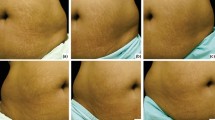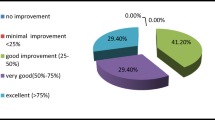Abstract
Striae gravidarum is a common dermatologic condition for females caused by multiple factors during pregnancy. It remains a therapeutic challenge especially in the striae alba (SA) stage, generating psychological and emotional distress to those affected. This study aims to compare the efficacy and safety of 1565-nm non-ablative fractional laser (NAFL) and fractional microneedle radiofrequency (MRF) for treatment of SA striae gravidarum. Fourteen Chinese women with SA striae gravidarum were included in this study. Patient abdomens were randomly divided into NAFL and MRF treatment sides, treated three times at 6-week intervals. Treatment efficacy was evaluated by subjective (clinical assessments, patient satisfaction rating, adverse effects assessment) assessments and objective (skin melanin index measurement, histological study) assessments. Clinical assessment suggested MRF was more effective (P = 0.0143) for improving the appearance of SA striae gravidarum. Both NAFL and MRF demonstrated effective improvement (P = 0.0082 and P = 0.0158, respectively), with no significant difference according to patient satisfaction ratings and changes in melanin index (P = 0.5900). Both treatments induced limited adverse reactions, but MRF treatment caused significant pain compared with the more moderate NAFL treatment (P = 0.0003). MRF treatment increased neocollagen and elastic fibers more significantly than NAFL, based on histological assessments (P = 0.0298 and P = 0.0048, respectively). MRF treatment improved collagen regeneration in SA striae gravidarum more than NAFL but caused considerable pain during treatment. Corresponding treatment or therapeutic strategies should be applied according to clinical scenario.




Similar content being viewed by others
References
Singh G, Kumar LP (2005) Striae distensae. Indian J Dermatol Venereol Leprol 71(5):370–372. https://doi.org/10.4103/0378-6323.16800
Kasielska-Trojan A, Sobczak M, Antoszewski B (2015) Risk factors of striae gravidarum. Int J Cosmet Sci 37(2):236–240. https://doi.org/10.1111/ics.12188
Al-Himdani S, Ud-Din S, Gilmore S, Bayat A (2014) Striae distensae: a comprehensive review and evidence-based evaluation of prophylaxis and treatment. Br J Dermatol 170(3):527–547. https://doi.org/10.1111/bjd.12681
Lupton JR, Alster TS (2002) Laser scar revision. Dermatol Clin 20(1):55–65. https://doi.org/10.1016/s0733-8635(03)00045-7
Cho S, Park ES, Lee DH, Li K, Chung JH (2006) Clinical features and risk factors for striae distensae in Korean adolescents. J Eur Acad Dermatol Venereol 20(9):1108–1113. https://doi.org/10.1111/j.1468-3083.2006.01747.x
Elsaie ML, Baumann LS, Elsaaiee LT (2009) Striae distensae (stretch marks) and different modalities of therapy: an update. Dermatol Surg 35(4):563–573. https://doi.org/10.1111/j.1524-4725.2009.01094.x
Silva PC, Guimaraes RN, Souza RG, Reis ZSN (2019) A quantitative cross-sectional analysis of the melanin index in the skin of preterm newborns and its association with gestational age at birth. Skin Res Technol. https://doi.org/10.1111/srt.12810
Salter SA, Kimball AB (2006) Striae gravidarum. Clin Dermatol 24(2):97–100. https://doi.org/10.1016/j.clindermatol.2005.10.008
Karimipour DJ, Kang S, Johnson TM, Orringer JS, Hamilton T, Hammerberg C, Voorhees JJ, Fisher G (2005) Microdermabrasion: a molecular analysis following a single treatment. J Am Acad Dermatol 52(2):215–223. https://doi.org/10.1016/j.jaad.2004.10.008
Elson ML (1990) Treatment of striae distensae with topical tretinoin. J Dermatol Surg Oncol 16(3):267–270. https://doi.org/10.1111/j.1524-4725.1990.tb03962.x
Ud-Din S, McAnelly SL, Bowring A, Whiteside S, Morris J, Chaudhry I, Bayat A (2013) A double-blind controlled clinical trial assessing the effect of topical gels on striae distensae (stretch marks): a non-invasive imaging, morphological and immunohistochemical study. Arch Dermatol Res 305(7):603–617. https://doi.org/10.1007/s00403-013-1336-7
Bak H, Kim BJ, Lee WJ, Bang JS, Lee SY, Choi JH, Chang SE (2009) Treatment of striae distensae with fractional photothermolysis. Dermatol Surg 35(8):1215–1220. https://doi.org/10.1111/j.1524-4725.2009.01221.x
Tretti Clementoni M, Lavagno R (2015) A novel 1565 nm non-ablative fractional device for stretch marks: a preliminary report. J Cosmet Laser Ther 17(3):148–155. https://doi.org/10.3109/14764172.2015.1007061
Suh DH, Chang KY, Son HC, Ryu JH, Lee SJ, Song KY (2007) Radiofrequency and 585-nm pulsed dye laser treatment of striae distensae: a report of 37 Asian patients. Dermatol Surg 33(1):29–34. https://doi.org/10.1111/j.1524-4725.2007.33004.x
Mishra V, Miller L, Alsaad SM, Ross EV (2015) The use of a fractional ablative micro-plasma radiofrequency device in treatment of striae. J Drugs Dermatol 14(11):1205–1208
Tian T, Luo YJ, Wang H, Chen HD, Li YH (2019) Efficacy and safety of a sublative bipolar fractional radiofrequency system combined with topical tretinoin in treating striae gravidarum: a randomized pilot study. Dermatol Surg 45(10):1245–1252. https://doi.org/10.1097/DSS.0000000000001933
Ryu HW, Kim SA, Jung HR, Ryoo YW, Lee KS, Cho JW (2013) Clinical improvement of striae distensae in Korean patients using a combination of fractionated microneedle radiofrequency and fractional carbon dioxide laser. Dermatol Surg 39(10):1452–1458. https://doi.org/10.1111/dsu.12268
Levame M, Meyer F (1987) Herovici's picropolychromium. Application to the identification of type I and III collagens. Pathol Biol (Paris) 35(8):1183–1188
Watson RE, Parry EJ, Humphries JD, Jones CJ, Polson DW, Kielty CM, Griffiths CE (1998) Fibrillin microfibrils are reduced in skin exhibiting striae distensae. Br J Dermatol 138(6):931–937. https://doi.org/10.1046/j.1365-2133.1998.02257.x
Zheng P, Lavker RM, Kligman AM (1985) Anatomy of striae. Br J Dermatol 112(2):185–193. https://doi.org/10.1111/j.1365-2133.1985.tb00082.x
Klehr N (1979) Striae cutis atrophicae. Morphokinetic examinations in vitro. Acta Derm Venereol Suppl (Stockh) 59(85):105–108
McDaniel DH (2002) Laser therapy of stretch marks. Dermatol Clin 20(1):67–76, viii. https://doi.org/10.1016/s0733-8635(03)00046-9
Rawlins JM, Lam WL, Karoo RO, Naylor IL, Sharpe DT (2006) Quantifying collagen type in mature burn scars: a novel approach using histology and digital image analysis. J Burn Care Res 27(1):60–65. https://doi.org/10.1097/01.bcr.0000192266.14329.7b
Harmelin Y, Boineau D, Cardot-Leccia N, Fontas E, Bahadoran P, Becker AL, Montaudie H, Castela E, Perrin C, Lacour JP, Passeron T (2016) Fractionated bipolar radiofrequency and bipolar radiofrequency potentiated by infrared light for treating striae: a prospective randomized, comparative trial with objective evaluation. Lasers Surg Med 48(3):245–253. https://doi.org/10.1002/lsm.22458
Adatto MA, Deprez P (2003) Striae treated by a novel combination treatment--sand abrasion and a patent mixture containing 15% trichloracetic acid followed by 6-24 hrs of a patent cream under plastic occlusion. J Cosmet Dermatol 2(2):61–67. https://doi.org/10.1111/j.1473-2130.2004.00023.x
Suh DH, Lee SJ, Lee JH, Kim HJ, Shin MK, Song KY (2012) Treatment of striae distensae combined enhanced penetration platelet-rich plasma and ultrasound after plasma fractional radiofrequency. J Cosmet Laser Ther 14(6):272–276. https://doi.org/10.3109/14764172.2012.738916
Kim IS, Park KY, Kim BJ, Kim MN, Kim CW, Kim SE (2012) Efficacy of intradermal radiofrequency combined with autologous platelet-rich plasma in striae distensae: a pilot study. Int J Dermatol 51(10):1253–1258. https://doi.org/10.1111/j.1365-4632.2012.05530.x
Kang S, Kim KJ, Griffiths CE, Wong TY, Talwar HS, Fisher GJ, Gordon D, Hamilton TA, Ellis CN, Voorhees JJ (1996) Topical tretinoin (retinoic acid) improves early stretch marks. Arch Dermatol 132(5):519–526
Rangel O, Arias I, Garcia E, Lopez-Padilla S (2001) Topical tretinoin 0.1% for pregnancy-related abdominal striae: an open-label, multicenter, prospective study. Adv Ther 18(4):181–186. https://doi.org/10.1007/bf02850112
Mallol J, Belda MA, Costa D, Noval A, Sola M (1991) Prophylaxis of Striae gravidarum with a topical formulation. A double blind trial. Int J Cosmet Sci 13(1):51–57. https://doi.org/10.1111/j.1467-2494.1991.tb00547.x
Buchanan K, Fletcher HM, Reid M (2010) Prevention of striae gravidarum with cocoa butter cream. Int J Gynaecol Obstet 108(1):65–68. https://doi.org/10.1016/j.ijgo.2009.08.008
Author information
Authors and Affiliations
Corresponding author
Ethics declarations
Conflict of interest
The authors declare that they have no conflicts of interest.
Informed consent
Written informed consent and image usage agreements were obtained from the patients prior to enrollment in the study.
Ethical approval
This study was approved by the Institutional Medical Ethics and Human Research Committee of China Medical University and was conducted in adherence with the ethical guidelines of the 1975 Declaration of Helsinki.
Additional information
Publisher’s note
Springer Nature remains neutral with regard to jurisdictional claims in published maps and institutional affiliations.
Rights and permissions
About this article
Cite this article
Tang, Z., Wen, S., Liu, T. et al. Comparative study of treatment for striae alba stage striae gravidarum: 1565-nm non-ablative fractional laser versus fractional microneedle radiofrequency. Lasers Med Sci 36, 1823–1830 (2021). https://doi.org/10.1007/s10103-020-03203-y
Received:
Accepted:
Published:
Issue Date:
DOI: https://doi.org/10.1007/s10103-020-03203-y




